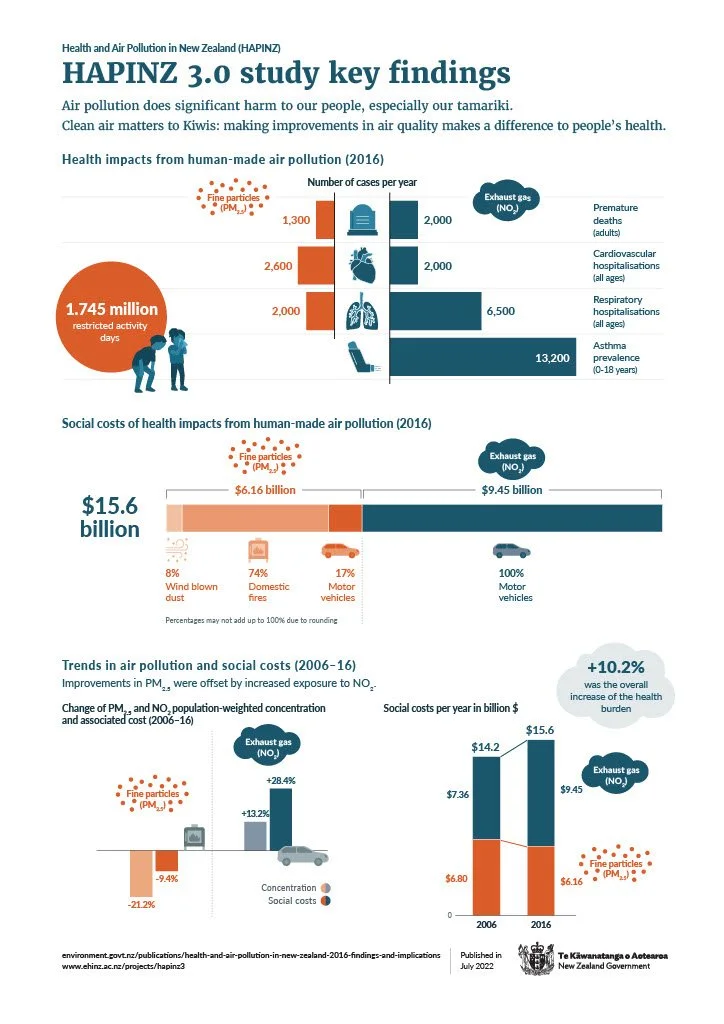The Dark Side of Wood Burning: Air Pollution
Published 25 July 2022
Clean, healthy air is vital for our health and wellbeing and winter is a time when our air quality suffers most. A key contributor to air pollution is wood burning.
Here we talk about the health impacts of air pollution, what causes poor air quality and how to make sure your heating isn’t adding to the problem.
Air pollution health impacts
Clean healthy air is vital for our health and wellbeing and winter is a time when our air quality suffers most. Evidence is growing to show how air pollution affects different aspects of health at even lower concentrations than previously understood.
The latest study on the health impacts of air pollution in New Zealand was published in July 2022 by Environmental Health Intelligence NZ (EHINZ.) In 2016, human-made air pollution in New Zealand Aotearoa resulted in an estimated:
3,317 premature deaths (in people aged 30+ years)
13,155 hospitalisations for cardiovascular and respiratory disease
13,229 cases of childhood asthma
What causes poor air quality?
Poor air quality is defined as being above the World Health Organization (WHO) 2021 guideline levels for particulates (PM2.5, PM10), ozone, nitrogen dioxide (NO2), sulfur dioxide and carbon monoxide.
EHINZ’s role is to provide information on how the environment affects our health and the latest Health and Air Pollution in New Zealand study looked at particulates and nitrogen oxide impacts on health. Particulate matter affects more people than any other pollutant. It is a mixture of solid and liquid particles of organic and inorganic substances suspended in the air and is measured in two ways:
There is a close relationship between exposure to high concentrations of PM10 and PM2.5 and increased mortality. Small particulate pollution has health impacts at very low concentrations – just takes longer to take affect people. Technically, there is no safe level of PM10 and PM2.5.
So where is all this nasty particulate coming from?
Chances are on a cold still day you’ll have smelt wood smoke in the air. While, motor vehicles are the largest contributor to air pollution health impacts, domestic fires are the second largest. Wood and coal fires for home heating in winter produce PM2.5. In 2016, the social costs due to air pollution from domestic fires were $4.6 billion and if there had been no air pollution from domestic fires, then almost 1,000 deaths would have been avoided.
But surely Wellington is too windy for us to worry about air pollution, right?
We’ve heard it loads of times, Wellington is too windy to worry about air pollution. Well, particulate emissions does have an impact on the outside air, but also the indoor air quality. A recent study by Public Health South senior analyst Dr Vanessa Hammond found that areas with a higher density of wood burners per hectare had higher rates of GP visits.
Overall 80% of New Zealanders lived in areas where PM₂.₅ exceeds current guidelines in 2016; but this proportion is 96.3% of people in Wellington region. A few regional figures:
80 premature deaths in Wellington
134 hospitalisations in Porirua
30,142 restricted activity days in Lower Hutt
What can I do if I already have a wood burner?
Don’t stress if you already have a wood burner. There are lots of things you can do to get a low smoke clean burn.
Get your wood right:
Moisture content of wood of between 12-20%. Measure with a moisture meter.
Make sure the wood is well seasoned (at least a year drying in a ventilated area)
Size of wood should be no more than 110mm in diameter
DON’T burn treated wood (treated, painted or drift wood)
Burn the wood right:
Light the fire using teepee or upside down method
Keep the firebox as hot as possible – smouldering fires release more emissions
Keep the firebox hot to keep the flue hot and therefore keep indoor air pollution down
Refuel every 20-30 minutes for radiata to keep fire hot
Get the chimney swept annually
When going to bed, DON’T pack the firebox and put on low. Instead, pull all hot coals to the front of the fire, clear the ash and tightly pack two logs at the back – this can last for around 6-8 hours of clean burning time.
Environment Canterbury has made an awesome guide to smoke free burning.
What can I do if I am thinking about new heating?
When selecting heating some of the things you’ll want to think about, other than the quality of the heat, are energy efficiency, running cost, capital cost and carbon emissions. For instance, heat pumps are the most energy efficient and cheapest to run; wood burners and pellet burners have a high capital costs but lower carbon emissions.
If you are set on a wood burner, then Ultra Low Emission Burners (ULEBs) have the least emissions and are the most efficient. The Ministry for Environment has a list of recommended ULEBs.
For more advice about heating, head to our blog.
A massive thank you to Mark Bourassa and Nola Collie from Environment Canterbury for giving their time and sharing their wealth of knowledge on this subject with us.



